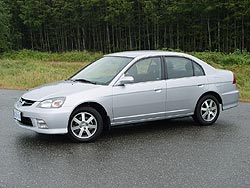 2004 Acura EL Touring. Click image to enlarge |
|
Related articles on Autos
Manufacturer’s web site
|
By Chris Chase; photos by Greg Wilson
As Canadians, we’re unique: we eat beaver tails, we put images of wild animals on our coins and we all live in igloos (well, according to some Americans, at least). Honda’s Acura division gave us another reason starting in 1997 – one that actually makes some of our neighbours south of the border a little jealous.
The 2001 Acura 1.7EL was the second generation of the entry-level model in Honda’s upscale brand’s line-up. The 1.7 in the name referred to the engine’s displacement in litres; while all 2001-2005 Civics used 1.7-litre motors, the one bolted into the EL was the same version that powered the Civic Si (127 hp/114 lb-ft) coupe and sedan (as distinct from the Si-R hatch, which used a 2.0-litre engine). Transmission choices were a five-speed manual or an optional four-speed automatic.
With an automatic transmission, the 2001 1.7EL’s Natural Resources Canada fuel consumption estimates were about 8.0/6.0 L/100 km (city/highway), with small variances year to year; the manual transmission made the car nominally thriftier in the city and thirstier on the highway.
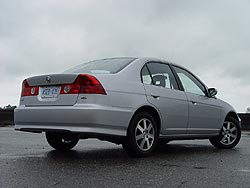 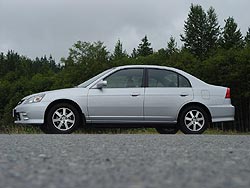 2004 Acura EL Touring. Click image to enlarge |
While the second-generation EL did share the poor ride that afflicted the new-for-2001 Civic, it benefits from the Civic’s generally solid reliability and great fuel economy. U.S.-based Consumer Reports doesn’t have reliability stats on the Canada-only EL, but even a quick glance at the magazine’s opinion of the 2001-and-up Civic tells you what you probably already suspected. This is a dependable little car, and the Civic’s status as one of Consumer Reports’ recommended used car buys puts this Honda twin near the top-of-the-heap, reliability-wise, among small luxury sedans.
I found a couple of posts at the web, two of them at ClubEL.ca (here and here), and another at Edmunds.com that point to an overheating problem with the 1.7-litre engine, but what’s unclear is whether the problem actually has to do with a flaw in the mechanicals, or owners habitually failing to check the coolant level.
Many of the complaints of overheating also mention the car being fine during highway driving, and only overheating when brought to a stop, plus a lack of heat from the climate system, both of which could point to a low coolant level. The bigger question, perhaps, is what’s happening to the coolant in these cars and whether it’s leaking, either onto the ground, or into the combustion chamber, through a bad head gasket. Consumer Reports makes no mention of any cooling system issues.
Here’s a thread at ClubEL.ca about wonky speedometers; there’s not much mention of this elsewhere on the web, so I doubt it’s widespread, but now you know the problem exists, just in case.
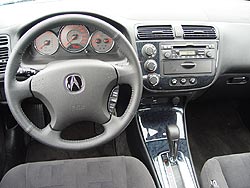 2004 Acura EL Touring. Click image to enlarge |
Consumer Reports notes transmission problems in 2001-2002 Civics, which, given the EL’s mechanical similarities to the Civic, means that this Acura would be susceptible to the same problem. From a search of the web, it appears the problem could be linked to a diagnostic trouble code that refers to the automatic transmission torque converter clutch. Apparently, the solenoid (a switch, basically) that engages and disengages the clutch can get clogged with debris from wear and tear inside the transmission. From what I can gather, the appearance of this code in the Civic points to an automatic transmission that might be close to needing a rebuild or replacement. If there’s a silver lining, it’s that the problem seems to mostly affect 2001 and 2002 models, with later cars largely avoiding trouble.
The 1.7EL wasn’t subjected to U.S. National Highway Traffic Safety Administration crash testing, but its Civic twin was. The Civic posted excellent results, earning five stars for both driver and front passenger protection in front impacts, and four stars each for front and rear seat occupant protection in side impacts.
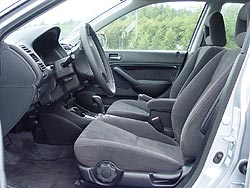 2004 Acura EL Touring. Click image to enlarge |
And those crash tests were conducted on a Civic without the side airbags that were standard on all 1.7 ELs, upping the safety ante even further. Other standard features included air conditioning, cruise, ABS and an anti-theft system. In 2001 models, a sunroof was standard only for Premium models, but was made standard across the line in subsequent years.
Used values range from $6,175 for a 2001 Touring model with manual transmission (the two available trims were Touring and the upscale Premium, which added leather seats, among other niceties) to a high of $12,625 for a 2005 Premium model with automatic transmission. The upsell from Touring to Premium was $2,000 in 2003, but on the used market, an EL Premium with stickshift is worth $9,475, or $725 more than the same car in Touring trim. By contrast, a 2003 Civic Sport with a manual transmission is worth $7,750, while a loaded Corolla LE (again, with a manual tranny) is valued at $7,850. If you’re in the market for some upscale niceties at a reasonable price, I’d dare say the Acura is a decent deal.
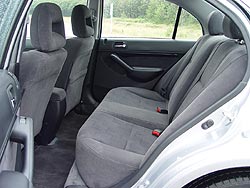 2004 Acura EL Touring. Click image to enlarge |
Of course, it bears mentioning what you don’t get, the most notable thing being the horsepower that most luxury vehicles pride themselves on offering, though depending on the model year, the EL was the only way to combine the Civic Si’s spunkier engine and a four-door body.
The price isn’t bad and reliability is good overall, but best avoid 2001 and 2002 models with the automatic transmission, unless you find evidence in service records that any tranny trouble has been dealt with already. Even then, I might suggest sticking with a manual or looking for a later-build car, just to save yourself potential trouble down the road. Regardless, get any car looked at by a trusted mechanic before you seal the deal.
|
Pricing
Black Book Pricing (avg. retail) October 2010:
Online resources
Recalls
2001: On certain vehicles,a small amount of water may have been left in the fuel pump electrical connector after testing. This residual water could cause the fuel pump to fail due to corrosion. If the pump stops working, the engine will stall without warning, increasing the risk of a crash. Correction: Dealers will inspect the fuel pump. If corrosion is found, the fuel pump electrical connector will be replaced.Transport Canada Recall Number: 2001170 Units affected: 3,417 2001: On certain vehicles, the hose clamps on the filler neck tube have insufficient clamping force. In a collision, the tube could disconnect from the fuel tank, resulting in fuel leakage. Fuel leakage, in the presence of an ignition source, could result in a fire. Correction: Dealers will check the hose clamps for proper torque and tighten them correctly if necessary. Transport Canada Recall Number: 2001264 Units affected: 37 2001: On certain passenger vehicles, the air cleaner box cover may have been damaged during the assembly process and a broken plastic piece could travel into the intake chamber. If the plastic piece lodges in the throttle body, the throttle could stick in a partially open position. Although the driver can always stop the car by applying brake force, or by taking other actions (i.e., shift into neutral, turn off the ignition key, etc.), if the car continues to maintain speed when the driver is expecting it to slow, a crash could occur. Correction: Dealers will inspect the air cleaner box for damage. If damage is found, the dealer will locate and remove the broken plastic piece, and replace the air cleaner box lid.
Crash test results
Used vehicle prices vary depending on factors such as general condition, odometer reading, usage history and options fitted. Always have a used vehicle checked by an experienced auto technician before you buy. For information on recalls, see Transport Canada’s web-site, www.tc.gc.ca, or the U.S. National Highway Transportation Administration (NHTSA)web-site, www.nhtsa.dot.gov. For information on vehicle service bulletins issued by the manufacturer, visit www.nhtsa.dot.gov. For information on consumer complaints about specific models, see www.lemonaidcars.com. |







 Follow Autos on Twitter
Follow Autos on Twitter



